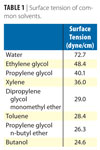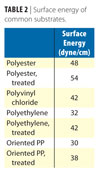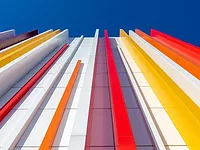A New Substrate Wetting Additive for Low-VOC Aqueous Adhesive Products
Complete substrate wetting must occur in order to obtain a strong adhesive bond. Effective wetting additives reduce the surface tension of the adhesive, enabling complete coverage of the substrate. Effective wetting additives are especially important for low-energy surfaces, which would otherwise resist coverage. In addition, if a substrate is contaminated, low-energy contaminant particles repel the adhesive, resulting in surface defects and a weakened bond. When an effective wetting additive is present, adhesives will wet any contaminants and/or low-energy substrates, thus creating a strong, unimpeded bond.
Troy Corp.’s multifunctional Troysol™ LAC provides excellent wetting of low-energy and contaminated surfaces, resulting in strong adhesive bonding. However, due to government regulations and consumer demand for environmentally compliant, green products, Troy has introduced Troysol ZLAC to fill the gap. HAPs-free, alkyl phenol ethoxylate (APE)-free ZLAC is a zero-VOC version of the traditional LAC product. It offers the same optimum substrate wetting performance as traditional LAC, but also enables the formulation of low-VOC aqueous adhesives products. ZLAC is a multifunctional, silicone-free wetting additive that improves substrate wetting, system flow and leveling, adhesion, gloss and color uniformity in aqueous coating, emulsion polymer, ink and adhesive applications.
Reducing Surface Tension2

|
| Figure 1 Click to enlarge |
High surface tension makes water inherently poor at wetting most substrates. A good example of this high surface tension is when a metal pin floats on the surface of water.
Troysol ZLAC was first evaluated for its ability to reduce surface tension, which is essential to enable complete wetting over low-energy substrates.

|
| Table 1 Click to enlarge |
Figure 1 shows how ZLAC was able to reduce the surface tension of water with use levels as low as 0.1%. Table 1 lists the surface tension values of typical solvents used in adhesives formulations. Conventional adhesive technology is based on solvents with low surface tensions. Conversely, aqueous adhesives require wetting additives to reduce the surface tension.
The use of wetting additives enhances the coverage of substrates with low surface energy (Table 2).

|
| Table 2 Click to enlarge |
An adhesive with a high surface tension in the liquid phase will have poor wetting over low-energy substrates, resulting in craters and/or severe crawling. ZLAC, however, effectively reduces the surface tension of water to 25 dynes/cm, enabling aqueous adhesives to spread over low-energy substrates.
Figure 2 shows a wetting test over a siliconized film. The formulation containing ZLAC provides complete coverage, while another formulation containing ethoxylated acetylenic diol, a commonly used wetting additive, showed severe crawling at equal concentrations.
Peel Strength Test

|
| Figure 2 Click to enlarge |
Peel strength tests are valuable for determining the strength of the adhesive bond between two materials. In order to evaluate the adhesive strength imparted by the wetting performance of Troysol ZLAC and LAC, peel strength tests were performed using three typical pressure-sensitive adhesive (PSA) formulations (see sidebar).
The following procedure was used for peel strength evaluation (180º Peel by PSTC 101 Test Method D):
- Apply the adhesive over untreated polyethylene terephthalate (PET) substrate;
- Apply the coated substrate on stainless steel panels after 24 hours of dwell time;
-
Use ChemInstruments TT-1000 tensile tester to measure peel strength.

Sidebar Click to enlarge

|
| Figure 3 Click to enlarge |
Troysol ZLAC was evaluated alongside LAC in formulations A and B. ZLAC was also evaluated separately at very low use levels, from 0.05-0.2% (weight additive based on total formulation), in formulations A, B and C to determine the lowest concentrations at which maximum peel strength was obtained.
Results and Conclusions
Test data show that substrate wetting imparted by ZLAC increases the peel strength in PSAs, and is the equivalent of the optimized performance offered by the traditional LAC product (Figures 3 and 4).

|
| Figure 4 Click to enlarge |
Both additives enhanced substrate wetting and increased peel strength, thereby imparting greater adhesive bonding and better film integrity.

|
| Figure 5 Click to enlarge |
In addition, concentrations as low as 0.05-0.1% ZLAC provided a substantial increase in adhesion for formulations A, B and C (Figure 5).
The use of zero-VOC Troysol ZLAC wetting additive has shown excellent substrate wetting efficacy equivalent to that of Troysol LAC when used in PSAs applied over low-energy substrates. ZLAC addresses the need for more environmentally friendly substrate wetting in adhesives and sealants. It can help formulators achieve defect-free films with excellent surface appearance and optimum adhesion performance, without VOC contribution.
For more information, visit www.troycorp.com.
Robert Miller, Dale Lyman and Sheila Belding of Troy Corp. contributed to this article.
Flexbond® is a trademark of Ashland Inc.; Aquatac® is a trademark of Arizona Chemical; Synthebond® is a trademark of Hexion; Tacolyn® is a trademark of Eastman; Acrysol® is a trademark of The Dow Chemical Co.; Acronol® and Collacral® are trademarks of BASF Corp; and Troysol™, Mergal® and Troykyd® are trademarks of Troy Technology.
This article originally ran in the February 2011 issue of Adhesives and Sealants Industry magazine.
Looking for a reprint of this article?
From high-res PDFs to custom plaques, order your copy today!






